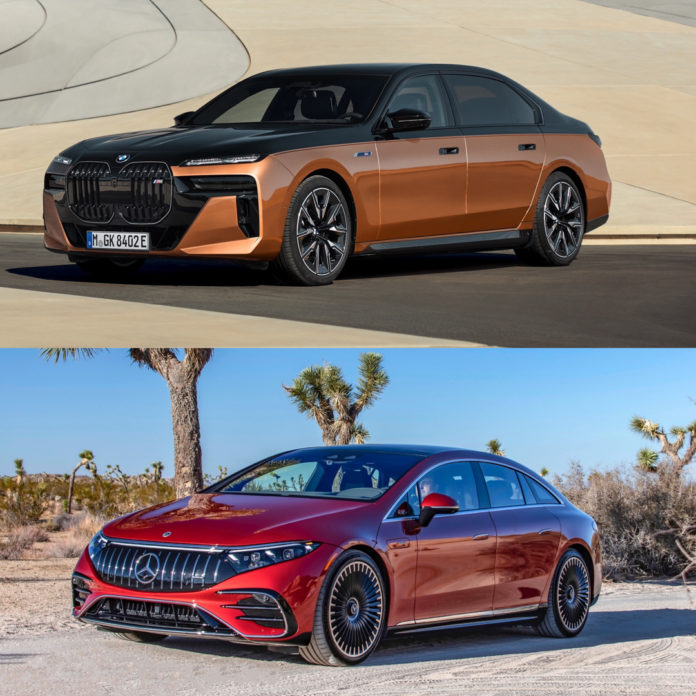You can add one more doubloon to the treasure trove of evidence that points to BMW’s hybrid and EV strategy seriously paying off. Mercedes-Benz has decided to axe the EQS moniker in favor of a diversified S-Class lineup, one that comprises full EV and gas-powered variants alongside one another. For the uninitiated, that’s exactly what BMW has done – and will continue to do – with the BMW 7 Series and i7. Of course, technically, this isn’t the first time Mercedes-Benz has pivoted. The new G-Class also shares the 7 Series approach of minimal aesthetic changes across models that use different propulsion methods.
Mercedes-Benz cites poor sales for the strategic shift. Both S-Class and EQS sales are far behind where they should be. That no doubt contributes to Mercedes-Benz landing quite far off the mark from their goal of 50 percent electrification across sales by 2025. Notably, a goal that has since been catapulted to 2030.
Comparing BMW and Mercedes-Benz Strategy

Despite the polarizing looks of the current 7 Series, it’s tough to argue with the facts being presented to us. The 7 Series is selling strong as ever, while Mercedes-Benz is struggling with the split-personality EQS and S-Class. S-Class sales are down 37 percent in the first quarter of 2024, and EVs only represent about 11 percent of their yearly sales in 2023. Part of this has to do with how the two German automakers took different approaches.
Mercedes-Benz built a dedicated platform for their EVs. Usually, a bespoke platform means lots of advantages over a shared one, as the vehicle can be more or less engineered from the ground up to perform its intended function the best. Consider the Porsche 911 – a sports car – vs. the M3, technically a modified 3 Series. Mercedes-Benz stretches or shrinks the platform to fit its models. In some ways, BMW does the same thing – scaling their CLAR platform up to the vehicle they need. But, there are no substantial differences underneath the sheet metal between the i4 and a traditional 4 Series or the i7 and a traditional 7 Series. EV, hybrid, or gas, the vehicle is built on the same platform.
Along with introducing a new architecture, Mercedes-Benz also chose to create entirely new nameplates for their EVs. That went along with different styling. The EQS and most of the Mercedes-Benz portfolio are styled radically differently than the brand’s mainstays, leaning futuristic in lieu of the traditional, almost 911-levels of incremental change that the S-Class sees. The result is a fractured customer base.
Something About Imitation and Flattery


None of these were cheap or easy decisions; but I can’t help but feel like BMW weighed the options and made an obviously better call. Both the 7 Series and EQS are massive, and they even sport identical wheelbases. While the i7 needs five more inches of total length to match the EQS’ interior space – and the S-Class beats it while remaining smaller – it’s nearly irrelevant since all the players measure well over 200 inches long. And we don’t speak for everyone, but the EQS styling wasn’t anything to write home about. Unlike the 7 Series – like it or not, it starts a lively conversation. The advantages that MB could’ve had with a dedicated EV platform all but disappeared.
While a lot of this seems like Mercedes-Benz playing catch up, the new strategy does deviate from BMW’s existing one in one important area. While the EQS nameplate will disappear, electric and gas S-Classes will be built on completely different platforms. Battery-powered variants will use MB.EA architecture, while gassers use updated MRA platforms. Essentially, things will remain the same under the sheet metal – just change outwardly.
It’s a strategy that should pay off for Mercedes-Benz in the long run. They are no longer splintering their customer base between a newcomer EQS and a time-tested S-Class nameplate, so things should get back on track. Frankly, it would be hard to sell fewer S-Class and EQS than they are now. [Source: Autocar]

